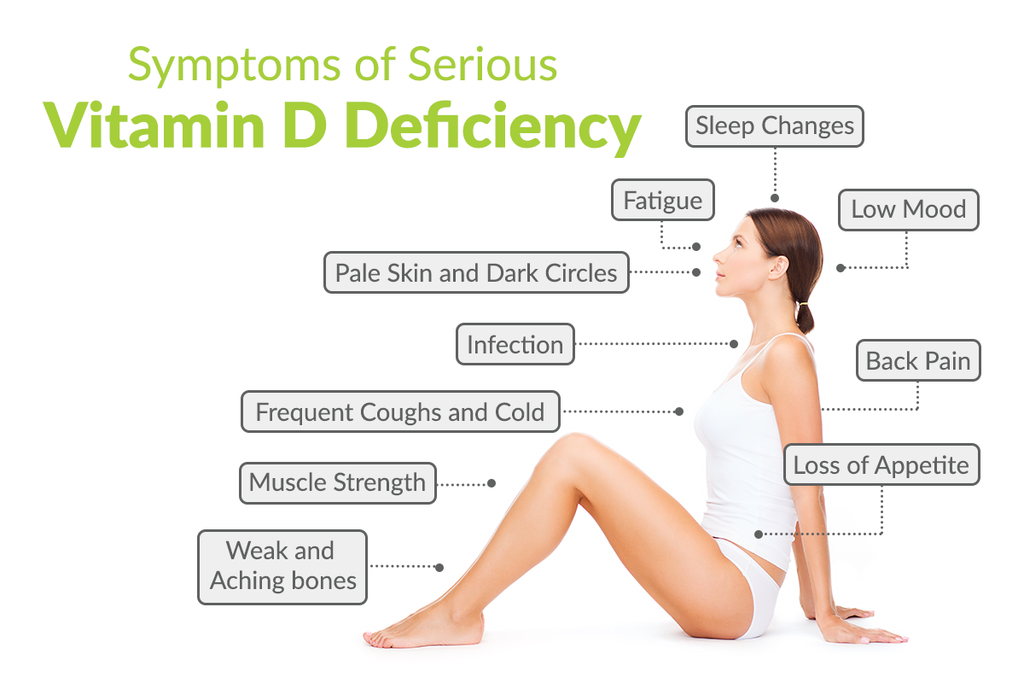James H. Lyons, BHSc Nutritional Medicine
James Lyons is a registered clinical nutritionist with special interest in preventative medicine, endocrine conditions and LGBTQI health. He is passionate about health education and patient autonomy, and he supports resources that empower everyone to make informed decisions about their health. James lives in the eastern beaches area of Sydney, Australia and works globally. Before he studied nutrition, James suffered from a vitamin D deficiency while travelling through England -- the effects of correcting the deficiency dramatically restored his sense of well-being and inspired him to move into his current career. Needless to say, he's passionate about vitamin D!
It's easier to correct a vitamin D insufficiency before it becomes a deficiency. In this article we'll uncover the subtle signs of low vitamin D levels that are often ignored when only looking for the blaring alarm bells of a flat-out vitamin D deficiency. You will learn why vitamin D is so important to literally every function in the body, why it can be so tricky to keep your levels up, and how to safely and quickly correct an insufficiency. Basically – everything you need to know about vitamin D, and more.
An estimated 1 billion people worldwide suffer from low levels of vitamin D. “Vitamin” is a misnomer for this nutrient – vitamin D is a pro-hormone steroid rather than a vitamin, and research has recently discovered that it controls an entire system within the body. Additional to its well-known role in bone health, vitamin D has a huge impact on DNA synthesis, cell differentiation, immune reactions, mood stability and cognitive health. It truly is an essential nutrient – its actions are necessary for the most fundamental body functions.
Because vitamin D is required for countless metabolic processes, a deficiency can cause a range of problems that you might not expect.
Causes of Vitamin D Deficiency
The majority of vitamin D is produced through a chemical reaction between the sun and the skin. Cells under the top layers of the skin interact with UV rays to create previtamin D. This fat-soluble metabolite is then released into the blood stream and activated through the kidneys and liver with the help of other nutrients such as magnesium and B vitamins. Previtamin D is metabolised into its bioactive form – vitamin D3. Quite a long process for such an essential nutrient, right?
Vitamin D levels can suffer from any disruption to this process such as inadequate sun exposure or impaired metabolism.
Factors affecting the amount of UVB to reach the skin include:
- Latitude
- Season
- Time of day
- Weather conditions
- Air pollution
- Skin tone – melanin in the skin blocks UVB absorption. Fairest skin types produce six times more vitamin D than the darkest skin types.
- Time spent indoors or covered up. The elderly, people with poor mobility or who are confined to the home, and people who wear clothing over their whole body and face are often unable to attain the minimum amount of sunlight exposure for healthy vitamin D levels.
Even with adequate exposure to UVB rays, an individual's vitamin D levels can suffer due to chronic kidney disease, liver conditions and cirrhosis, medications that increase the excretion and requirement of vitamin D, including glucocorticoids and anticonvulsants, and inflammation of any kind. Additionally, elderly people have thinner skin that is less able to produce vitamin D. For anyone suffering from Vitamin D deficiency, there is an increased need due to illness, surgery, infections or stress.
Bone Problems, Growing Pains & Osteoporosis
Vitamin D is an essential nutrient for bone health. Its supports the skeletal system via three main mechanisms:
- Vitamin D regulates the levels of calcium found in the blood. Alongside parathyroid hormone, vitamin D can stimulate the absorption of calcium from food, release calcium from the bones into the blood and stop the kidneys from excreting it into the urine. Vitamin D keeps calcium levels in check.
- Vitamin D is required for the transcription of a protein called “osteocalcin” which attaches calcium to the bone. Without vitamin D, calcium cannot adhere to the matrix core of the bone and the skeletal system can become weak and brittle.
- Vitamin D is essential for proper structure and form of bone tissue. Through its role in cellular division, vitamin D encourages maximum bone density by creating a well-structured matrix for calcium and other minerals to adhere to.

Without adequate vitamin D, bones can become soft, brittle, weak and malformed and cause serious conditions in adulthood:
- Osteoporosis is directly linked to vitamin D deficiency. This degenerative condition can occasionally present with symptoms of sore bones, but often has no symptoms except for loss of height and easy bone fractures. Post-menopausal women are most at risk, but anyone can develop osteoporosis from a vitamin D and subsequent calcium deficiency.
- Osteomalacia is a softening of the bones caused by vitamin D deficiency. Symptoms include lower back pain that then spreads to the arms and legs, chronic fatigue, and muscle weakness.
Symptoms of a serious vitamin D deficiency can show up in the musculoskeletal system:
- Muscle aches
- Muscle weakness
- Bone pain at any age
- Lower back pain that then spreads to the arms and legs
- Chronic fatigue due to unrecognised, tiny fractures
- Loss of height
- Easily fractured bones and healing complications. Vitamin D deficiency increases the likelihood of injury and spread of bone fractures by up to 31%.
Growing pains in children have little to do with skeletal development, but they are related to vitamin D. These dull aches occur during growth spurts but are caused by muscular tiredness, poor posture and emotional triggers. Vitamin D deficiency may be a common cause of growing pains. A 2015 study of 120 children showed that supplementing with vitamin D significantly decreased the intensity and frequency of growing pains. It may be its relationship with magnesium and calcium that links vitamin D to growing pains – these minerals are essential for muscle relaxation and any disruption to their metabolism due to low vitamin D levels could cause cramping.
Fatigue, Dark Circles & Pale Skin
When you think of anaemia, do you think about iron? Or maybe a sneaky vitamin B12 deficiency? Surprisingly, a lack of red blood cells can also be caused by low levels of vitamin D. Red blood cells develop within bone marrow – with its role in bone health and cell synthesis, vitamin D is essential for the growth and release of red blood cells into circulation.
TIP: Did you know that vitamin D improves iron absorption by reducing hepcidin and inflammation?
Red blood cells that are poorly formed or in low numbers struggle to deliver enough oxygen to meet the energy requirements of tissue and organs throughout the body. This can cause systemic symptoms of anaemia including:
- Fatigue or tiredness no matter how much sleep you get.
- Exhaustion or shortness of breath when climbing stairs or walking up an incline.
- Reduced endurance, fitness and strength.
- Headaches, dizziness or light-headedness.
- Sluggish metabolism.
- Loss of appetite.
- Slow wound healing.
- Dark circles under the eyes or pale fingernails.
- Pale skin on the side of eyelids – this one is hard to identify, but pull down the bottom lid, and have a look in the mirror! The skin here should be bright pink and flushed, not pale or dry.
Frequent Infections, Slow Healing & Immune Dysfunction
Vitamin D and immunity should be as synonymous as vitamin D and sunshine. The immune system requires ample vitamin D for essential immune functions and cell proliferation.
In fact, immune cells love vitamin D so much that these bug-fighters contain abundant vitamin D receptors and enzymes that can convert the prohormone into its active D3 form. Without vitamin D, immune cells would be unable to multiply, tell friend from foe, detect invading germs, or mount attacks on pathogens.
Low levels of vitamin D can cause:
- Increased susceptibility to infection. Do you seem to get sick every time you're near someone with the sniffles? You might need a vitamin D boost.
- Slow recovery from infections. Vitamin D deficiency can drag an acute common cold into a two-week respiratory infection and a cough that just won't go away.
- Post-operative complications. Surgical wounds require vitamin D for proper healing and prevention of infection. Vitamin D acts on the cutaneous level of the skin as an antimicrobial agent, protects against environmental damage and encourages fast closure of wounds. Recent research concluded that having healthy pre-operative vitamin D levels can improve the success rate of surgeries.
TIP: In 2017, researchers performed a large meta-analysis on the current evidence and concluded that regularly taking a vitamin D supplement can prevent acute respiratory tract infections including the common cold and influenza. The researchers found that the benefits aren't limited to those with a vitamin D deficiency – supplements can even boost immune defences in to people who have normal vitamin D levels!
Inflammation & Vitamin D
Vitamin D is a key step in wound healing. Signals are sent to reduce inflammation after the initial stages of healing are complete, but sometimes those signals get skewed. Guess which pro-hormone acts as an anti-inflammatory messenger? You got it – vitamin D.
Low levels of vitamin D may increase the risk of developing chronic inflammation conditions such as:
- Cardiovascular disease
- Asthma
- IBS
- Kidney disease
- Liver disease
- Multiple sclerosis
- Diabetes complications
- Chronic lower back pain
Autoimmune Conditions & Vitamin D
Low levels of vitamin D have now been linked rheumatoid arthritis (RA), an autoimmune condition. In 2017, researchers found that people who recently diagnosed with RA were more likely to have a low level of vitamin D, that that vitamin D can control inflammation in RA, and that the vitamin-hormone could help protect against other conditions associated with RA like gingivitis and bone fractures.
Other autoimmune conditions have also been linked to vitamin D deficiencies. In these cases, vitamin D deficiency may add to the risk of a genetically pre-disposed person developing the condition, or the condition may increase the risk of a vitamin D deficiency:
- Psoriasis, especially in conjunction with coeliac disease
- Multiple sclerosis
- Inflammatory bowel disease
- Systemic lupus erythematosus
Upshot: Low levels of vitamin D increase the risk of immune dysfunction, while healthy levels may help to protect against the development of RA and other autoimmune conditions. Vitamin D may also help to relieve some autoimmune symptoms, so get your levels checked if you suffer from an autoimmune condition or if someone in your family does – these kinds of conditions run in the family!
Low Mood, Poor Concentration & Cognition Problems
Receptors for vitamin D are widespread throughout the brain. As well as protecting neural tissue against inflammation, oxidative damage and plaques, vitamin D is utilised in nerve signalling. Low concentrations of vitamin D may increase the risk of cognitive decline in older age and the onset of Alzheimer’s disease and dementia.
New research has also found that low vitamin D levels may be a risk factor for mental health issues in adolescence and childhood, and that supplementation may help to relieve symptoms in adults with clinical depression and Seasonal Affective Disorder. A 2017 study suggested that calcium levels may be a driving factor in depression. Calcium is an essential mineral for the activation of signals between nerve cells, and higher intracellular levels of this mineral may cause those signals to misfire. Theory goes that vitamin D can help to regulate the levels of calcium within neural cells and alleviate depression.
Regardless of the cause, low vitamin D levels are strongly associated with the symptoms and onset of clinical depression and Seasonal Affective Disorder, and supplementation may help to alleviate symptoms in patients with a confirmed deficiency.
Symptoms to keep an eye out for include:
- Sadness with no explanation
- Other moods that linger for a long time. Apathy, anger or irritability
- Fatigue and lethargy
- Unexplained weight gain or weight loss
- Appetite changes
- Sleep changes – either sleeping too much, being unable to fall asleep, or waking up very early
- Clumsiness
IMPORTANT: Speak to a healthcare practitioner if you are experiencing symptoms of depression, ongoing low mood, or are having difficulty with your memory. They can check your vitamin D levels and recommend appropriate treatment. Self-prescribing vitamin D supplements may help relieve symptoms in some people, but they aren't effective as a stand-alone treatment.
Vitamin D Deficiency in Babies & Children
With its role in skeletal and cellular development, you can imagine the widespread issues that a growing infant could face with low levels of vitamin D.
A mother's passes on her vitamin D to the foetus during pregnancy and her levels generally determine the concentration of vitamin D in the new-born infant. Even with a good start from mom, a deficiency can develop anytime during childhood, particularly in children who spend little time outdoors during daylight hours or have compromised liver or kidney function.
Babies, children and adolescents can suffer from these serious symptoms of vitamin D deficiency:
- Softened bones and skull
- Delayed sitting and crawling in older infants
- Delayed fontanelle closure
- Development of “rachitic rosary” - growths on the ends of the ribs that appear as prominent knobs or beads under the skin of the ribcage
- Delayed walking in children aged 1 – 4
- Painful walking in older children and adolescents
- Bone fractures that happen easily and frequently
- Bowlegs, knock-knees and flattened pelvic bones are extreme manifestations
Correcting a Vitamin D Deficiency, The Right Way
A vitamin D deficiency can be confirmed through a blood test. Levels of at least 20 to 24 ng/mL (about 50 to 60 nmol/L) are required as a minimum for bone strength, though higher levels may be necessary for optimal health. Anything less than 20ng/mL is considered a deficiency.
Sunlight Therapy
For healthy people, direct sunlight exposure to the arms, face, hands and legs is recommended for 5 – 15 minutes, three times a week. It may take more sunlight exposure than this to correct a deficiency and many people find they need to take a vitamin D supplement in addition to increased time outdoors.
CAUTION: Speak to a practitioner for personal advice as any UV exposure can increase the risk of skin cancer.
Vitamin D from Food
The majority of the body's vitamin D must be produced from sunlight in the intricate, complex and potentially pot-holed method described at the beginning of this article. But small, intermittent requirements can be filled through the diet – tiny amounts of vitamin D are found in fatty fish, beef, liver and eggs. This animal-derived form of vitamin D is active vitamin D3 and is the same molecule that the body creates from sunlight. Unfortunately, very little vitamin D is absorbed in the intestines from food and can't be relied on to correct a serious deficiency or even maintain adequate levels in lieu of sunlight.

Vegetarian food sources of vitamin D are even trickier. Mushrooms contain vitamin D2, an inactive pre-cursor to vitamin D3 that needs to be converted in the body into its active form. Again, because vitamin D is not readily absorbed by the intestines, this is not an adequate method to keep vitamin D levels high or to correct a deficiency.
To complicate things further, absorption of vitamin D in the intestines is halved when there is a low level of vitamin D in the blood. This means that people with a vitamin D may struggle to absorb any vitamin D from food.
Don't worry – this is what supplementation is designed for!
How to Use Vitamin D Supplements
Supplementation is a common and effective way to boost vitamin D levels and is the front line therapy for vitamin D deficiency.
Therapeutic dosage to correct a deficiency starts at 1,000IU. An ongoing dose of 500IU is commonly used to maintain healthy levels during times of increased need or reduced sun exposure.
TIP: Speak to a qualified nutritionist, naturopath or doctor for personalised advice.







